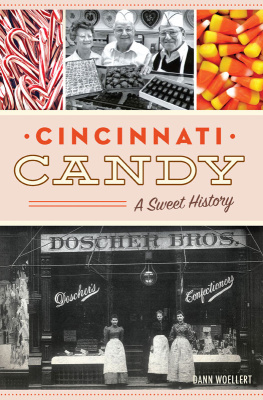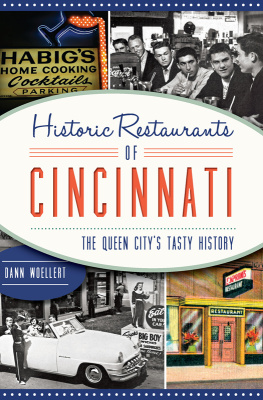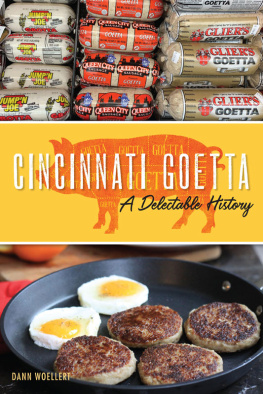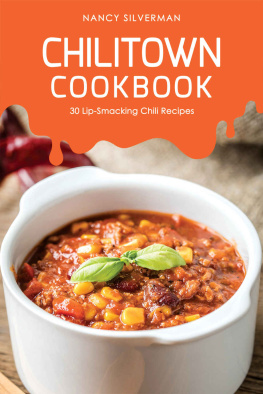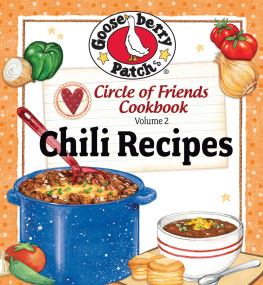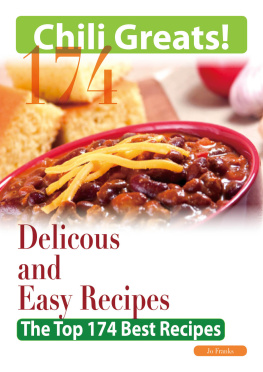

Published by American Palate
A Division of The History Press
Charleston, SC 29403
www.historypress.net
Copyright 2013 by Dann Woellert
All rights reserved
First published 2013
e-book edition 2013
Manufactured in the United States
ISBN 978.1.62584.062.2
Library of Congress Cataloging-in-Publication Data
Woellert, Dann.
The authentic history of Cincinnati chili / Dann Woellert.
pages cm
Includes bibliographical references.
print edition ISBN 978-1-60949-992-1
1. Chili con carne--History. 2. Restaurants--Ohio--Cincinnati--History. 3. Restaurants--Ohio--Cincinnati Region--History. 4. Cincinnati (Ohio)--Social life and customs. 5. Cincinnati Region (Ohio)--Social life and customs. I. Title.
TX749.W63 2013
641.8236--dc23
2013012608
Notice: The information in this book is true and complete to the best of our knowledge. It is offered without guarantee on the part of the author or The History Press. The author and The History Press disclaim all liability in connection with the use of this book.
All rights reserved. No part of this book may be reproduced or transmitted in any form whatsoever without prior written permission from the publisher except in the case of brief quotations embodied in critical articles and reviews.
To my favorite foodie, Jeanne.
CONTENTS
INTRODUCTION
MEET CHILITOWN, USA
Cincinnati-style chili is as unique as the Ohio River city that gave its name. Some would argue that its not chili at all. But to the many Cincinnati devotees whove developed the crave, thats just heresy. Invented by two Slavic-Macedonian immigrants, the brothers Kiradjieff, in a burlesque theater in downtown Cincinnati during prohibition, it has become a more than $100 million industry. The Kiradjieffs created a virtual chili diaspora in the city. How could they have known the legacy they were to create? That legacy in Cincinnati boasts more than 250 chili parlors, more per capita and square mile than in any city in the world. Roughly 225 of those parlors are split between corporate brands Skyline Chili and Gold Star Chili, and the rest are independents or smaller chains. Snowbirds can enjoy Skyline Chili in Fort Lauterdale, Florida, and four other locations in the Sunshine State. It has spread as far as the Middle Eastern nations of Jordan and the United Arab Emirates. Since December 2012, pilgrims can even visit the birthplace of Christ and eat Cincinnati-style chili at the Bethlehem Chili House, founded by the son of Fahid Daoud, one of the founding brothers of Gold Star Chili. Christ and a cheese coneywhat a religious experience!
Cincinnati-style chili has achieved a cult status in the region. Wedding photos in Cincinnati have shown brides stuffing cheese coneys into grooms faces rather than pieces of cake. Two weddings have taken place at the Bellevue Kentucky Gold Star. Owner Chill Rick Schmidt provided cake and free meals to the newlyweds. Women have found diamond rings hidden in a bowl of oyster crackers in a chili parlor. And even as unusual as it may sound, some Cincinnati families have replaced the traditional Thanksgiving turkey dinner with a chili bar, complete with all the fixings. Cincinnati chili has made it into country songs like Coming to Your City and blues songs like Camp Washington Chili.
Cincinnati chili for natives is a taste thats developed from birth. And to out-of-towners, you either love it or hate it. Its been called culinary barbary, faux chili and even weak spaghetti sauceouch! Its made news in the New York Times and numerous culinary magazines, as well as on a variety of Food Network programs. A particularly bitter female Cincinnati food critic once said that she couldnt understand why people were eating it. Word to the wise: if you want to live comfortably in Cincinnati, dont bash the chili.
The numbers dont lie about chilis popularity in Greater Cincinnati. The Cincinnati Chamber of Commerce estimates that Cincinnatians annually go through 2 million pounds of chili topped by 850,000 pounds of shredded cheddar cheese. The Clifton Skyline once reported that it sold 1,600 York Peppermint Patties at its counter to save the onion breath of its customers. Dixie Chili reported that it went through a combined 1,000 pounds of cheese per week, and the Clifton Skyline reported that it consumes roughly 250 pounds of cheese per week. Good thing were not a city of lactose intolerant people!
Cincinnati chili is similar to most peasant or comfort foods. Its most popular form, the three-way, is mostly inexpensive starch in the form of spaghetti, with a small layer of meat and a sprinkling of cheese on top. Its both economical and filling. Its a bit like another Cincinnati favorite, goetta, which uses a little bit of pork and a filler of pinhead oats and spices. Goetta was invented by German immigrants in Cincinnati in the mid-nineteenth century. In the same way you wont find a version of Cincinnati chili anywhere in Greece, you wont find a version of goetta anywhere in Germany. What is it about Cincinnati that makes inventing new food categories so appealing?
The other most popular form of Cincinnati-style chili is the cheese coney. The cheese coney has its roots on Coney Island in New York in that it contains chili piled over a hot dog on a bun. But thats where the similarity ends. Its a bit like comparing Cro-Magnon men to modern Homo sapiensrelated but different. Comparing Coney Island chili to Cincinnati chili is like comparing goetta to its East Coast cousin, scrapple, which is made with cornmeal in the place of pinhead oatmeal. Its clear that we have something better in Cincinnati on both accounts, and some chili parlors serve both delicacies together.
Cincinnati expats whove developed the crave request frozen chili from relatives and the dry spice blends from their new homes around the world. A 2010 industry report commissioned by Gold Star Chili estimated that Greater Cincinnatians spend $16 million at the grocery buying frozen and canned products, as well as ingredients, to make their own versions of Cincinnati-style chili. And the Cincinnati chili parlor is on the trifecta of places to visit when they return home (along with LaRosas and Graeters Ice Cream). I recently posted a comment on Facebook about Cincinnati chili just to see where it would go. A nonnative friend commented in the negative, and you couldnt imagine the flurry of comments from chili lovers rushing to defend their hometown favorite.
As a native myself, Ive read countless Enquirer and Cincinnati magazine articles about Cincinnati chili. But I wanted to get to the bottom of Cincinnati chili mythology. I wanted to call on the chili oracles, be inspired by the chili muses and trace the Cincinnati chili family tree. For me, many questions remained unanswered. Who was the first to invent the formula, and will we ever know the unique spice blend? Whats different between each of the chili formulas? How did we come to use cheddar cheese instead of a more Greek cheese like feta? What was happening in Macedonia and Greece that made the scores of Greek- and Slavic-Macedonian immigrants move to Cincinnati during World War I? Did Skyline and Dixie Chili steal the recipe from Empress? Is the blend based on a traditional Greek dish like moussaka or pastichio? Does it really have cinnamon and chocolate in the formula? Whats the proper way to eat a three-wayinverted or normal, dry or juicy, cutting or swirling? Does the type of oyster cracker affect the taste of the chili?
Next page

